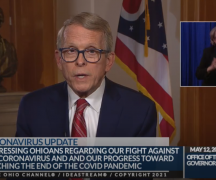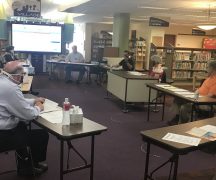WASHINGTON — As the COVID-19 virus continues to sweep the country, voting rights advocates are demanding Congress fully fund a national vote-by-mail program so people aren’t forced to choose between their health and their right to vote.
But for large swaths of the population, voting by mail isn’t a viable option.
The voting debacle in Wisconsin this month offered a cautionary tale for other states grappling with how to vote during a pandemic.
When Wisconsin’s Supreme Court ruled their April 7 election could not be postponed, and the U.S. Supreme Court declined to give absentee voters more time, people were forced to risk their health in order to vote. In hard hit, predominantly black areas, like Milwaukee, a shortage of poll workers led to further crowding at fewer polls, disproportionately impacting populations that are already more vulnerable to the virus, according to the Milwaukee Journal Sentinel.
Lawmakers and advocates took to Twitter to demand vote-by-mail. “This is an outrage. Americans need #VoteByMail,” wrote Oregon Sen. Ron Wyden (D).
California Rep. Adam Schiff (D) wrote: “We need to be prepared for easy and secure vote by mail everywhere in November. It’s non negotiable.”
But remote voting doesn’t work for many with disabilities, those who require assistance reading, those without a permanent address, Native populations without reliable mail delivery, many with limited English, and still others who have a historic distrust of the system.
Allison Riggs, chief voting counsel for Southern Coalition for Social Justice, said that during the Jim Crow era, it was not uncommon for black voters’ registration and ballots to be stolen.
“That was the white supremacy machine getting rid of black votes,” she said. “That’s a lasting scar and trauma that is part of the reason historically in the South, black voters have tended to prefer in person voting.”
Sam Berger, the vice president of democracy and government reform for the Center for American Progress, said there are a number of common steps officials across the country can take to ensure elections are safe and yield stable voter turnout.
“It’s not that they’re easy. They’re complicated and take time and resources. But we know what they are,” he said. “Vote by mail, and at the same time, maintain in-person options and expand them.”
Congress allotted $400 million for voting administration in its last COVID-19 relief bill, billions short of what advocates say is needed. In a preliminary calculation, the Brennan Center estimated it would cost $2 billion to ensure safe, enfranchised voting.
Another problem, Berger said, is that the pandemic is playing into broader voting-related politics.
At a press conference last week, President Donald Trump called voting by mail “horrible” and “corrupt.” When a reporter pointed out that Trump had voted by mail in the last election, the president said, it was “because I’m allowed to.”
Trump later claimed in a Tweet that voting by mail is fine for members of the military and senior citizens, but is “ripe for fraud” for others.
While states work to expand voting options during the pandemic, many advocates are urging officials to keep in mind people who cannot vote by mail.
“As we are looking at options, we need to include options that work for the disability community, people with language access issues, native populations, and others who might not have a permanent address,” said Sylvia Albert, director of voting and elections for Common Cause.
“Those people who cannot be forgotten in our rush to find a perfect fix.”
Kat Calvin is the founder of Spread of the Vote, a group that works to help the large population of American citizens without proof of identification, about 11 percent of eligible voters, obtain government-issued IDs in order to exercise their right to vote. She said many of the people she works with are unhoused and do not have access to the internet.
“So what happens if it is all vote by mail? How do we help our clients?” she said. “If we have to do virtual education, can we ship a laptop to one of our shelter partners? But we can’t have a bunch of people crowded in a room around a computer. Can I put on a hazmat suit and pick up some ballots for them?”
Calvin said vote-by-mail should be part of a comprehensive voting package, but it’s not “a panacea.”
Terry Ao Minnis, senior director of census and voting programs for Asian Americans Advancing Justice, said language barriers are a main driver for a consistent turnout gap between Asian American voters and white voters, and the confusion caused by the pandemic — in combination with xenophobic harassment and discrimination against Asians and Asian Americans — is only making matters worse.
“It is possible this harmful sentiment spills over into the voting context where we have already seen discrimination against Asian Americans because of false perceptions of the ‘perpetual foreigner,’” she said. “We may see an increase in unfounded challenges to Asian American voters for simply being Asian or we could even see an increase in attacks against Asian Americans seeking to vote.”
Voting rights advocates agree that while conducting primaries during the pandemic is complicated, politically fraught, and logistically frustrating, it is necessary to ensure the funds are secured and the kinks are worked out before the general election in November.
“Everyone kind of needs to pony up right now,” Riggs said. “If our democracy dies during this pandemic in addition to thousands of Americans, it’s really game over.”
***
More from Ohio Capital Journal:
COVID-19 is hitting black & poor communities the hardest, underscoring fault lines in access and care for those on margins
As the COVID-19 epidemic continues to ravage the American public, an unsurprising story emerges: Poor communities are hot spots for COVID transmission. The death rate from COVID-19 appears to be staggeringly high among African Americans compared to whites. The Washington Post reports, for example, that while 14% of the Michigan population is black, 40% of COVID-19 deaths are among blacks.
This is a familiar pattern to a social and infectious disease epidemiologist like myself. It is evidence of centuries of segregation and discrimination that have disproportionately placed people of color in communities without access to health care, with degraded and crowded living conditions and a lack of basic opportunities for health and wellness.
In the context of the current pandemic, blacks are more likely to have low-paying jobs that do not allow remote work options or offer health insurance or paid medical leave. The result of centuries of sidelining by American society plays out most obviously in worse health. READ MORE





